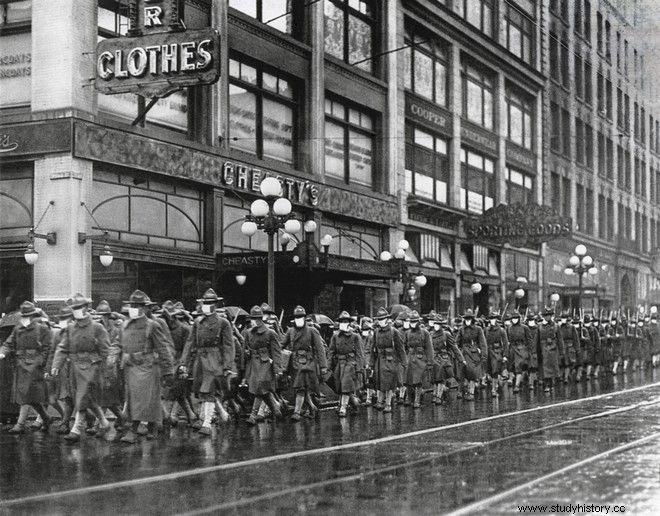Pandemics, such as the one experienced by the whole planet in recent months with the coronavirus, bring to light in the harshest way the weaknesses of societies but at the same time give lessons, even if hard, to humanity for its survival.
Plague pandemics and that of 1918, responsible for countless deaths over the centuries, forced societies to improve their coping strategies, offering valuable knowledge to future generations about similar situations.
After all, humanity, as it has been proven, is resilient and learns to adapt to new conditions. Here are five ways he did it:
1. Quarantine
The quarantine measure was implemented for the first time in history in July 1377 in the port of Ragusa (present-day Dubrovnik in Croatia) during the bubonic plague, which has gone down in history as the Black Death. "Those coming from contaminated areas will not enter the Ragusa region, unless they spend a month in the islet of Mrkan or in the city of Cavtat, for the purpose of disinfection," according to the regulation. Doctors then noticed that the spread of the Black Death could be slowed by isolating people.
Quarantine played a major role in how 20th-century American cities responded to the outbreak of the 1918 influenza pandemic, or Spanish flu, after soldiers returned from World War I. In San Francisco, sailors arriving in the city were quarantined. In San Francisco and St. Louis, social gatherings were banned and theaters and schools were closed. Philadelphia, in contrast, became an example to avoid for future pandemics and their management, when 72 hours after a parade, the city's 31 hospitals were filled with patients.
2. Social distancing when receiving food and drinks
Italy, as now with the coronavirus, was also the epicenter of a pandemic in the past. During the Italian Plague (1629-1631), the wealthy citizens of Tuscany devised a clever way to sell the contents of their cellars without going out into the potentially infected streets:the wine windows.
Narrow windows were made in houses to allow wine sellers to give out their wares to waiting customers. Something we also saw during the Covid-19 period in cities like New York with the cocktail windows. Wine sellers in the 17th century even used vinegar as a disinfectant when accepting payments. There are over 150 wine windows in the city of Florence, and 400 years after the plague, they have "revived" amid the coronavirus pandemic to serve customers, offering everything from wine and coffee to ice cream.
3. Use of a mask

Doctors treating patients during the plague wore masks with long bird beaks. They had the right idea—large beaks created distance between patient and doctor and at least partially covered their mouths and noses—but the wrong science. Doctors then believed in the miasma theory, according to which diseases spread through foul odors in the air. Beaks were often filled with strongly aromatic herbs, which were believed to ward off disease.
During the 1918 flu pandemic, masks became the means to stop the spread of infection. Masks became mandatory in San Francisco in September 1918, and those who did not comply faced fines, imprisonment and the threat of having their names published in the newspapers as "mask refusers".
But the papers weren't just for shaming the unruly. They also provided instructions on how citizens can make masks at home. Many even took the opportunity to unleash their creative genius, with the Seattle Daily Times publishing an article titled "The New Fashion in Influenza Masks" in October 1918.
4. Washing hands and surfaces
Hand washing to reduce the spread of disease is now an accepted part of hygiene, but in the early 20th century it was something new. To encourage its application, ground-floor bathrooms first appeared as a way to protect families from germs brought by visitors and those who brought home coal, milk, and ice.
Until then, visitors passed through several areas of the house to use the bathroom, carrying germs. ("Typhoid Mary" spread the disease from which she got her nickname by improperly washing her hands before handling food).
The germ theory was a relatively new idea introduced in the mid-1800s by Louis Pasteur, Joseph Lister, and Robert Koch, who argued that disease was caused by microorganisms invisible to the naked eye. A sink on the ground floor made it easy to wash hands on the way home.
There's also a reason why hospitals, subways, and bathrooms in the 1920s often had white tiles:White tiles are easy to clean and make any dirt visible.

5. Fresh air and tailored training
Education and school closures are a complex issue in any pandemic.
Clean air was found to be the solution to curbing the tuberculosis epidemic in the early 1900s that was killing 450 people a day - many of them children. Germany pioneered the idea of open-air schools, and in 1918, had more than existed in 130 American cities. The clean air movement also inspired urban planners to create more green spaces to promote public health.
During the second wave of the Spanish flu in the fall of 1918, public schools in Chicago and New York remained open. At the time, New York's health commissioner told the New York Times:"Children leave their often unsanitary homes for large, clean, airy school buildings, where there is always a system of inspection and control."
It should be noted that in 1665, the then-young Isaac Newton was sent back to his family's farm by Cambridge University after an outbreak of the plague. This is the farm where he allegedly witnessed the fall of the apple that led to his law of gravity.
Read the News from Greece and the world, with the reliability and validity of News247.gr.
